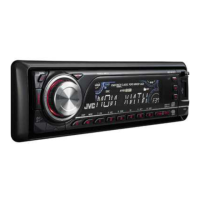What to do if 'PLEASE' and 'EJECT' appear alternately on the JVC KD-G737 display?
- DDerek PatelJul 31, 2025
If “PLEASE” and “EJECT” are alternately displayed on your JVC Car Receiver, this can occur due to overheating. You should eject the disc.

What to do if 'PLEASE' and 'EJECT' appear alternately on the JVC KD-G737 display?
If “PLEASE” and “EJECT” are alternately displayed on your JVC Car Receiver, this can occur due to overheating. You should eject the disc.
How to fix JVC KD-G737 when tracks on CD-R/CD-RW cannot be skipped?
If tracks on the CD-R/CD-RW cannot be skipped on your JVC Car Receiver, finalize the CD-R/CD-RW with the component used for recording. If this does not work, try ejecting the disc. As a last resort, change the disc.
| Power Output | 50W x 4 |
|---|---|
| RMS Power | 22W x 4 |
| Tuner | AM/FM |
| CD Playback | Yes |
| MP3 Playback | Yes |
| WMA Playback | Yes |
| USB Input | No |
| Aux Input | Yes |
| Bluetooth | No |
| Equalizer | 3-band |
| Subwoofer Output | Yes |
| Display Type | LCD |
| Detachable Face | Yes |
| Channels | 4 |
Essential warnings for Class 1 laser products, covering unit access and direct viewing.
Safety advice for driving operation, volume limits, and temperature considerations.
Procedures for resetting the unit and forcibly ejecting a disc.
Guides to disable the demonstration mode and set the unit's clock accurately.
Instructions for safely removing and reattaching the detachable control panel.
Detailed explanation of the main control panel buttons and their operations.
How to switch between audio sources and control the unit's volume.
Explanation of various indicators and information shown on the unit's display.
Instructions for installing the remote battery and basic operation pointers.
Safety warnings for remote use and the functions of its various buttons.
How to tune radio stations, preset them, and improve FM stereo reception.
Using PTY codes to search for programmes and storing favorite types.
Activating/deactivating TA/PTY standby and network-tracking reception for continuous listening.
Inserting discs, playback, stopping, ejecting, and prohibiting disc ejection.
Selecting tracks and folders, and controlling playback modes for digital audio discs.
How to connect USB storage devices and play compatible audio files.
Details on repeat and random playback options for USB content.
Safe removal of USB devices and important warnings for their use.
Navigating tracks and folders on USB devices and display information.
Mentions the need for a Bluetooth Adapter for wireless operations.
Step-by-step guide for pairing new Bluetooth devices via OPEN or SEARCH.
Managing connections with registered and available Bluetooth devices.
Managing incoming calls, auto-answer, and SMS notifications via Bluetooth.
Methods for making calls using call history, phonebook, and voice commands.
How to store phone numbers for quick access and dialing.
Connecting and controlling audio playback from Bluetooth audio devices.
Information on connecting a CD changer and its compatibility with the unit.
How to select discs and tracks, including folder navigation for MP3s.
Details repeat and random playback options for CD and MP3 discs.
How to tune DAB services, search for ensembles, and store them.
Explains alternative frequency reception for DAB services.
Connecting iPod/D. Player via dedicated interface adapters.
How to navigate menus and control playback for iPod/D. Player devices.
Using line input or AUX adapters to connect additional audio components.
Selecting external input and adjusting volume/sound for connected devices.
Visual guides for connecting various external devices like CD changers and iPods.
Details on available EQ presets like Rock, Pop, Jazz, and their settings.
How to fine-tune Bass, Mid, Treble, Fader, Balance, Loudness, and Subwoofer.
Steps to access and modify PSM items for personalized audio configurations.
Managing display demonstration, clock display, and automatic clock adjustment.
Configuring AF reception, PTY standby, and TA volume.
Adjusting DAB volume, display dimmer, and telephone muting options.
Settings for subwoofer crossover, external inputs, and amplifier gain control.
Configuring automatic connection, call answering, and message notifications.
Adjusting microphone settings and viewing Bluetooth software/hardware versions.
Guidelines for cleaning unit connectors and maintaining disc cleanliness.
Proper disc handling, dealing with condensation, and avoiding incompatible discs.
Operating power, storing radio stations, and understanding RDS functions.
Information on compatible discs and warnings for DualDisc playback.
Common disc playback problems and file format requirements for MP3/WMA/AAC.
Limits on file/folder names and hierarchy depth for disc playback.
Compatible audio formats and their requirements for USB playback.
Information on USB device recognition, file limits, and incompatible file types.
Safe USB removal and general precautions for Bluetooth device usage.
Notes on DAB service presetting and iPod/D. Player operation modes.
Solutions for no sound, unit malfunction, static noise, and disc playback errors.
Addressing issues with MP3/WMA/AAC file playback, format, and naming.
Solutions for USB device detection, file playback, and character display problems.
Troubleshooting Bluetooth pairing, connection failures, and poor sound quality.
Resolving issues with interrupted Bluetooth audio, echo, noise, and AVRCP control.
Solutions for CD changer errors like 'NO DISC', 'RESET 8', and general non-operation.
Remedies for DAB signal issues, reset messages, and tuner functionality.
Solutions for iPod/D. Player connection, sound distortion, and playback errors.
Detailed specifications for the audio amplifier, including power, impedance, and frequency response.
Technical details for FM/AM tuners, covering sensitivity, selectivity, and frequency ranges.
Specifications for the CD player and USB section, including format compatibility and transfer rates.
General unit details such as power, temperature, dimensions, and mass.
